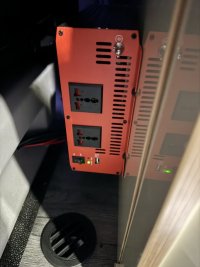Hi all
I recently (last week) purchased a converted T6.1. I love it, without this forum though it would be much less enjoyable as it’s so complicated figuring out where everything goes etc.
When I purchased it, the guy who sold it me said all manuals were inside… and they were not. So, here I am trying to figure out how to plug my laptop etc in, when not connected up to mains on a camp site etc.
Pictures attached here show my inverter, which is behind the drivers seat. As well as my electric management device -
Basically, the first night I purchased the van… I went out and camped out off grid, all day. 24 hours ish. After that; the icon on the black square was flashing to show car battery was low (40% left) I was confused why the leisure battery wasn’t showing low. But I just packed up and went home, eventually the car symbol went away as I was driving I assumed it naturally charged.
Anyway, I tried to plug my laptop in… and it worked. For the last week… I’ve been told by a friend who said he knows a few things, the inverter behind the drivers seat needs to be turned off at all times, and you turn it on when you’re plugged into mains on a site etc. so that’s what I’ve done. However, whenever I’m using the van, lights on and I haven’t turned the engine on for a while… it then states car battery low. This makes me think it’s not using the leisure battery at all?
I turned the inverter on via the power button, as you can see in the image it shows a green light. I then tried using the plug sockets beneath the USBs on the wall (in the other picture) and they wouldn’t work. I asked the guy I purchased the van off, and he said plug into the inverter directly. And the plug sockets beneath the USBs only work when you’re on a site plugged into mains. Again, very very confused now.
I plugged into the inverter directly, and nothing. Didn’t work. My father in law thinks the leisure battery had died as it has never actually been switched on.
I basically, just need a breakdown of what to do when I’m camping “off” grid, and “on grid” sorry if I’m coming across useless - this is new to me and I feel so baffled.
Thanks so much if you read this much, you guys are so helpful.


I recently (last week) purchased a converted T6.1. I love it, without this forum though it would be much less enjoyable as it’s so complicated figuring out where everything goes etc.
When I purchased it, the guy who sold it me said all manuals were inside… and they were not. So, here I am trying to figure out how to plug my laptop etc in, when not connected up to mains on a camp site etc.
Pictures attached here show my inverter, which is behind the drivers seat. As well as my electric management device -
Basically, the first night I purchased the van… I went out and camped out off grid, all day. 24 hours ish. After that; the icon on the black square was flashing to show car battery was low (40% left) I was confused why the leisure battery wasn’t showing low. But I just packed up and went home, eventually the car symbol went away as I was driving I assumed it naturally charged.
Anyway, I tried to plug my laptop in… and it worked. For the last week… I’ve been told by a friend who said he knows a few things, the inverter behind the drivers seat needs to be turned off at all times, and you turn it on when you’re plugged into mains on a site etc. so that’s what I’ve done. However, whenever I’m using the van, lights on and I haven’t turned the engine on for a while… it then states car battery low. This makes me think it’s not using the leisure battery at all?
I turned the inverter on via the power button, as you can see in the image it shows a green light. I then tried using the plug sockets beneath the USBs on the wall (in the other picture) and they wouldn’t work. I asked the guy I purchased the van off, and he said plug into the inverter directly. And the plug sockets beneath the USBs only work when you’re on a site plugged into mains. Again, very very confused now.
I plugged into the inverter directly, and nothing. Didn’t work. My father in law thinks the leisure battery had died as it has never actually been switched on.
I basically, just need a breakdown of what to do when I’m camping “off” grid, and “on grid” sorry if I’m coming across useless - this is new to me and I feel so baffled.
Thanks so much if you read this much, you guys are so helpful.






